Items tagged with 'economic development'
Capital Region economic development grants: residential conversions, sewers, Lincoln Park pool, Urban Grow Center
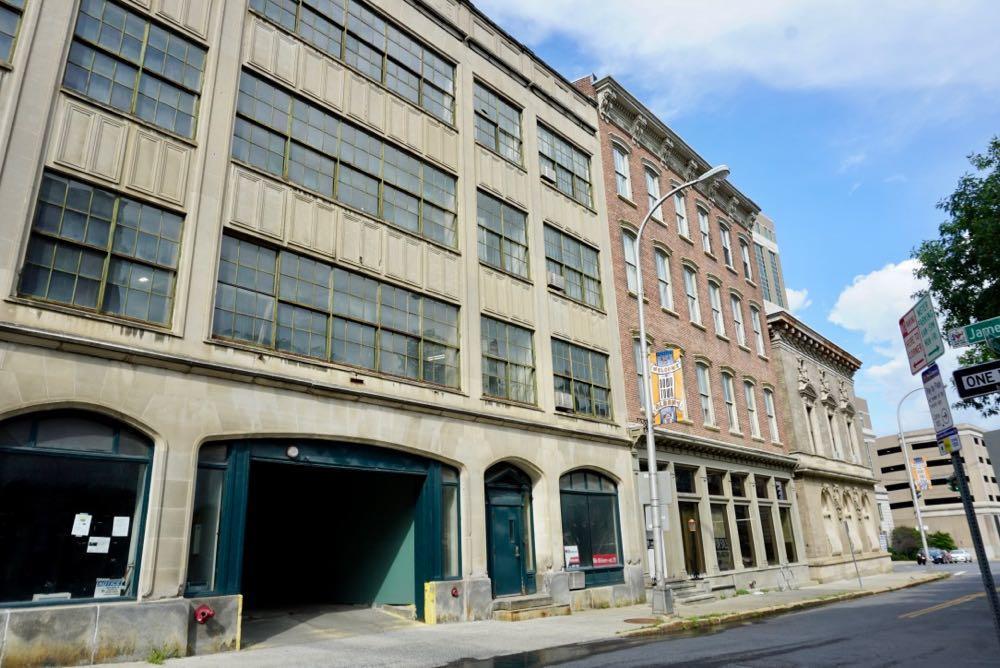
The residential conversion of the Kennedy Garage in downtown Albany is line for a $1 million grant.
The Capital Region scored $67 million in the state's annual Region Economic Development Council awards/game show/porktacular on Tuesday.
The region was not a "top performer" this year -- the awards roughly broke out into $80some million and $60some million tiers this time around. (The Capital Region had been in the higher tier the last two years.)
Here are details on the specific projects getting funding in the Capital Region are below, along with a bunch of that caught our eye. There are also region-by-region totals for the awards.
Downtown Albany is in line to get $10 million from the state -- here are some of the projects that could get a slice of that money
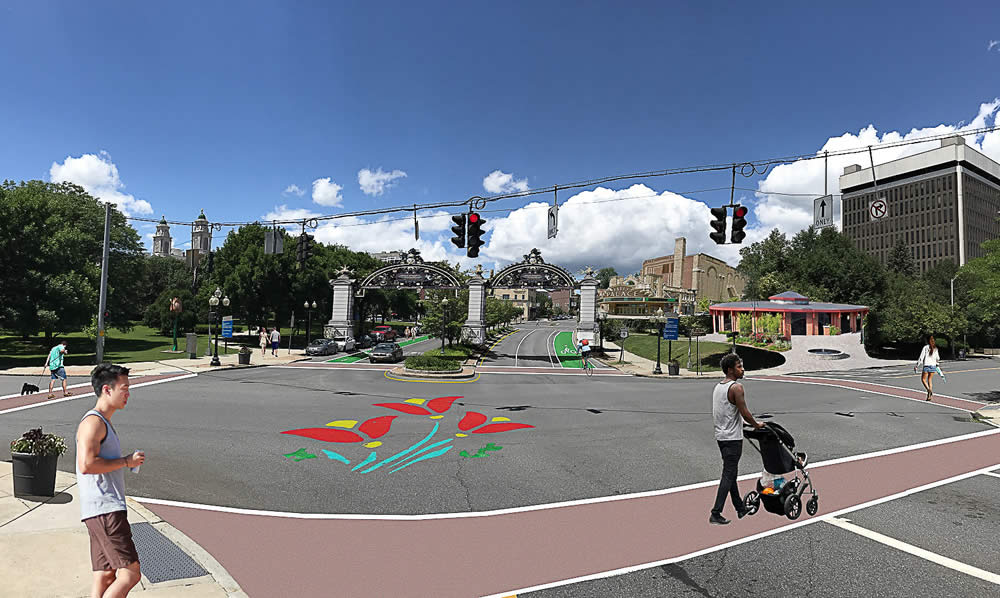
A rendering of a potential gateway at Broadway and Clinton that Capitalize Albany released last year.
A bunch of projects in downtown Albany are in line to get a slice of a $10 million block of money from New York State after the city was named one of the winners in the latest round of the state's Downtown Revitalization Initiative.
Specifically, Capitalize Albany -- the development arm of the city -- put together an application that focused on the Clinton Square area of downtown. It's the section more or less centered on the intersection of North Pearl Street and Clinton Ave. The pitch was that this area is a major gateway to the city, is the interface for multiple neighborhoods, and already has some momentum in the form of real estate development, affordable housing, and the arts.
Albany was in the running against a handful of other cities in this region, including Troy and Cohoes.
So what's up for the cash? Here's the list, along with a few thoughts.
Creative Economy Symposium 2018
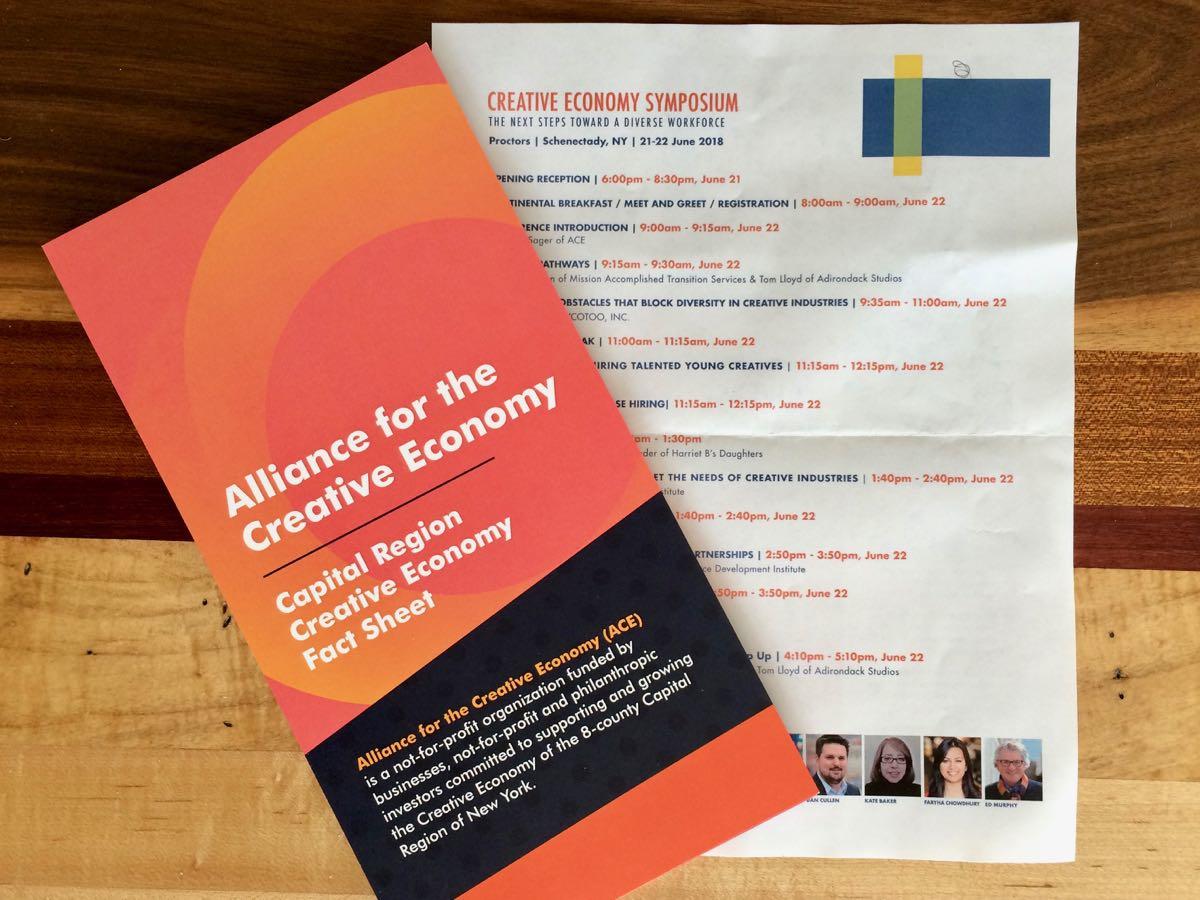
Proctors is hosting the second annual Creative Economy Symposium June 21-22. The topic for this year's event: "The Next Steps Toward a Diverse Workforce." Blurbage:
Join Upstate [Alliance for the Creative Economy], Workforce Development Institute, and the Themed Entertainment Association, global experts, and regional individuals, entities & industries in exploring critical issues relating to cultural, social and racial inclusion in Upstate New York's Commercial Creative Industries.
This 2nd Symposium in Schenectady involves Employees & Employers in Regional Creative Industries engaged in a conversation about overcoming obstacles, educational curriculum, hiring practices, job placement services, and career opportunities, rural & urban, leading us to a more diverse workforce.
Updated: A flyer with the schedule of events and speakers is embedded below. There's an opening reception that Thursday evening and then presentations/talks/discussions during the day on Friday.
Diversity in the local creative economy was the subject of a recent event at the Opalka Gallery this month. It was a good discussion, and there's a lot to talk about -- especially on how to turn intent into action and results.
The registration deadline for the symposium at Proctors is June 15. The fee is $40. (If that's maybe more than you can cover, we get the sense the organizers don't want to turn anyone away for not being able to pay -- so reach out to them.)
Amazon Town
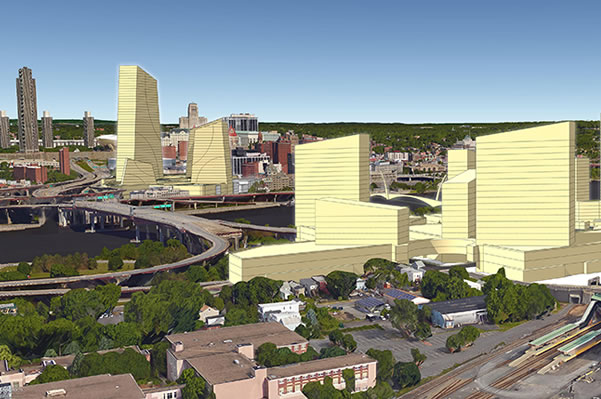
One of the renderings from the Capital Region's Amazon HQ2 bid.
You might recall that episode back in October when the Capital Region joined the mad rush to be colonized by Amazon -- there was pitching, there was laughing, and Albany experienced one of its regular cycles of self hatred. (Here are the 20 metros that made the cut as finalists.)
Well, now the Capital Region's full bid is out thanks to Jon Campbell and the crew at the USA Today Network. They FOILed the bids for the Buffalo, Rochester, Syracuse, and Albany metros from Empire State Development and posted them online. Here's the Capital Region bid.
On initial scan, it's pretty much what you'd expect from the summary released last year. But there were a few things that caught our eye...
A potential map for Troy's future
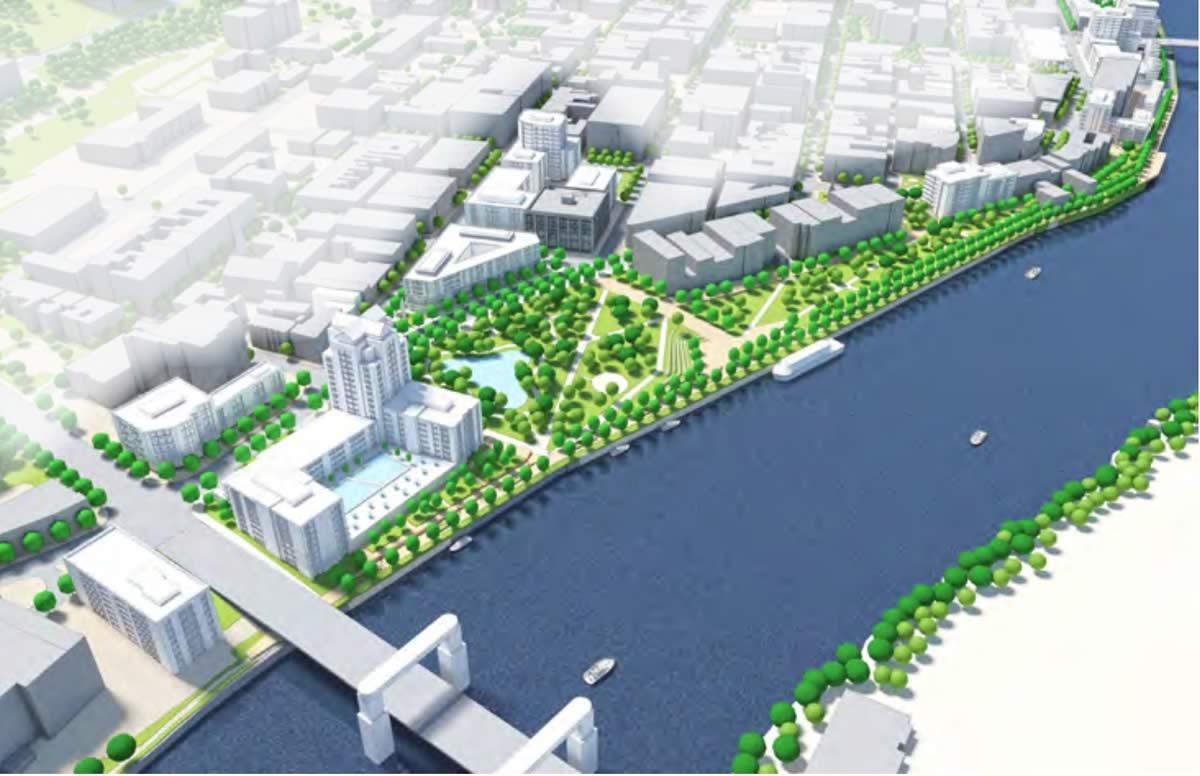
A conceptual plan for a reconfiguration of the riverfront in downtown Troy.
The draft of Troy's new comprehensive plan -- Realize Troy -- was released this week after more than two years in the making. It's basically a proposed road map for the city's future over the next 25 years and beyond.
The full draft is available over at the Realize Troy site.
We read through the plan this week and picked out a handful of bits that caught our eye -- from a major reconfiguration downtown to... forks.
Capital Region economic development grants: sewer systems, The Palace, Cohoes Canal Square Park, Capital Roots, and more
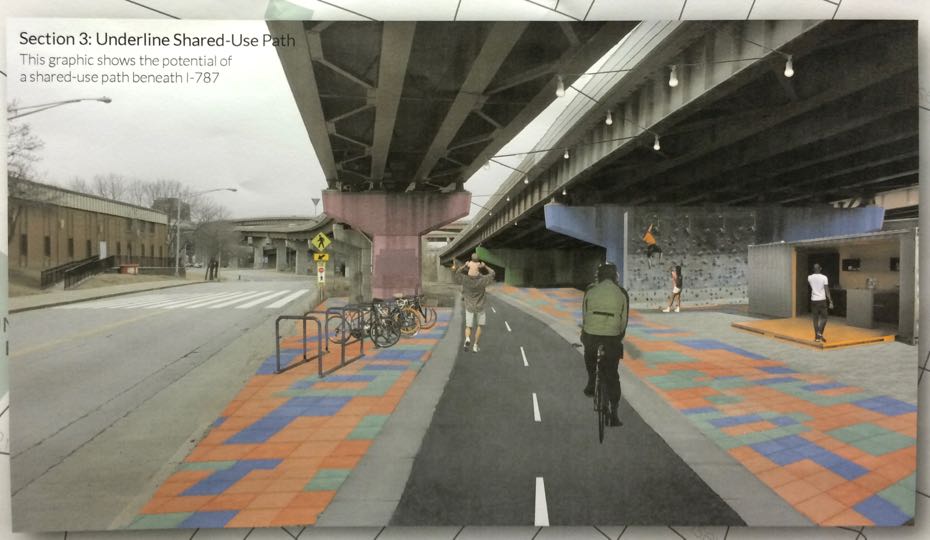
Albany's plan to build a connector between the Mohawk Hudson Bike Hike Trail and the Helderberg-Hudson Rail Trail got funding.
The Capital Region scored $85 million in the state's annual Region Economic Development Council awards/game show porktacular on Wednesday. The region was a "top performer" for the second year in a row, and again landed the second-highest total of grants.
Here are details on the specific projects getting funding in the Capital Region are below, along with a bunch of that caught our eye. There are also region-by-region totals for the awards.
A snapshot of the Capital Region pitch to Amazon
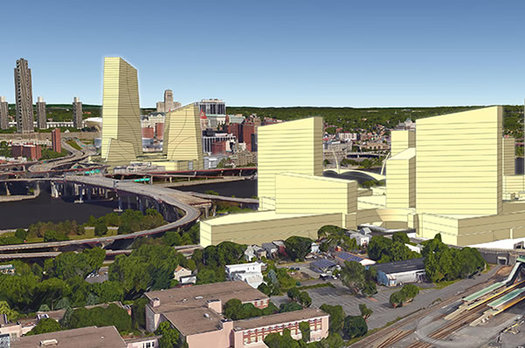
Today is the day that cities and metropolitan areas all around the country are offering themselves up to Lord Bezos as his empire looks to build an off-world colony beyond Amazon Prime in Seattle.
The Capital Region is one of those metros, and the Center for Economic Growth has posted an overview of its pitch. It centers on a a potentially massive new complex spanning the Hudson River at Albany and Rensselaer. A clip:
With Amazon specifying an interest in a downtown or urban location with a layout similar to its Seattle campus, CEG's centerpiece proposal is the Amazon Promenade. This downtown headquarters would straddle the iconic Hudson River, with a capacity for 2 million square feet of office space in the City of Albany's 25-acre site between the Times Union Center and Broadway and an additional capacity for 6 million square feet on 75 acres directly across the Hudson in the City of Rensselaer. The Albany and Rensselaer sites could be connected with a pedestrian bridge across the Hudson, water taxies and/or a gondola.
There are a handful of renderings -- and we've pulled them out for easy gawking. The online pitch also argues the region's case in terms of aspects such as education, housing affordability, natural disaster susceptibility, and crime.
The assimilation of the Capital Region by the Bezos is a low probability event -- this place is competing against pretty much every other relatively large metropolitan area in the US and Canada. That said, here are a few very quick thoughts...
Scanning the Capital Region Economic Development Council's 2017 priority projects
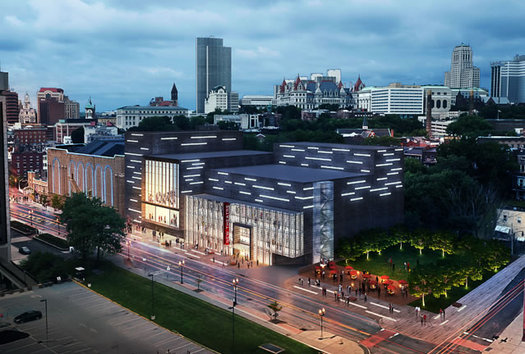
The proposed Palace expansion is back up for state money.
The Capital Region Regional Economic Development Council released its 2017 progress report this week. And one of the things that's immediately notable about these reports is the list of proposed priority projects up for state money in the next round of the Cuomo administration's Regional Economic Development Council initiative.
You know, these are the grants that are announced at an awards-show-like event, usually in December.
The list usually includes some interesting bits, and it also sometimes surfaces notable projects that are in the works.
So, let's have a look at a handful of items that caught our eye. They include mixed-use residential projects, the Schuyler Building renovation, the Capital Roots Grow Center, and -- for a second year -- the proposed Palace Theatre expansion...
Examining the forces and maps that redlined the city of Albany

From a 1938 Home Owners’ Loan Corporation map of Albany.
The Digital Scholarship Lab at the University of Richmond recently published a website displaying redlining maps from the 1930s for American cities with populations over 50,000. These so-called Residential Security Maps, along with detailed descriptions of urban neighborhoods, give us insight into how the flow of bank funds into some areas -- and their denial in others -- shaped the postwar American city.
We researched the history of these maps, as well as related records pertaining to Albany, at the National Archives. Here's what we found.
Capital Region economic development grants: Tivoli Preserve, Albany Skyway, Nipper, Troy movie theater, craft beverages, and more
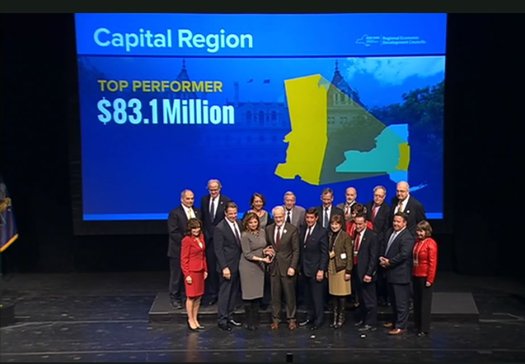
Originally published Thursday at 2:20 pm. Updated Thursday at 4:05 pm.
The Capital Region got $83.1 million in the state's annual Regional Economic Development Council awards/game show on Thursday. That total made it a "top performer" -- and it was the second-highest total of any region.
The details on the specific projects getting funding in the Capital Region are below. There are also region-by-region totals for the awards.
The announcement included many of the same elements as previous years, including specious claims about the economic vitality of upstate and that weird "no, you're the best" dynamic between Maria Bartiromo and Andrew Cuomo. (Sadly, the state has still not installed a giant wheel on stage for representatives of each regional economic development council to spin and reveal their total.)
One bit of other news that came out of the presentation: Andrew Cuomo reiterated his support for allowing services such as Uber and Lyft to operate upstate.
His statement -- "I guess I support Uber upstate." -- followed a deadpan joke by Empire State Development head Howard Zemsky about requesting an Uber to take him to The Egg from the ESP office in Albany -- the car showed up 2 hours and 45 minutes later and took him to Price Chopper.
Scanning the Capital Region Econ. Development Council's new batch of priority projects

A rendering for the planned mixed-use conversion of the Nipper Building in Albany's Warehouse District.
The Capital Region Economic Development Council recently released it latest batch of proposed priority projects. These are the projects the council will be suggesting get state funding in the next round of the Cuomo administration's Regional Economic Development Council initiative. Those awards are usually announced in December.
Last time out in the economic development competition/game show the Capital Region scored $98 million in grants. (It missed out on one of the three $500 million grants.)
These reports usually include some interesting bits and sometimes surface notable projects that are in the works.
So, let's have a look at a handful of proposed projects that caught our eye. They include craft beverage projects, a movie theater project for Troy, and the proposed Palace Theatre expansion...
A large chunk of the Harriman State Office Campus is for sale

From the listing site. / image: CBRE / NYS OGS
The Cuomo admin announced Wednesday that it's seeking proposals for the purchase and development of 27 acres on the eastern end of the Harriman State Office Campus in the city of Albany. Press release blurbage (emphasis added):
The RFP calls for plan that builds on the current redevelopment of the existing campus, reflects the area's character, and increases the City of Albany's tax base through a wide range of potential options including companies in the healthcare, technology, research, education, retail, and hospitality sectors. Uses could include offices, medical and laboratory facilities, retail shops, lodging, and ancillary parking. A minimum purchase price of $5.1 million is required and any proposal that includes residential use will not be accepted.
The Cuomo admin has laid out a two-phase process for selecting the winning bidder. The first phase -- in which "potential developers will provide a description of the proposed uses for the site and demonstrate the need for or likely success of those uses" -- closes September 15. The three bidders with the highest scores will then move onto the second and final phase in which they'll have to provide more specific details about things like funding.
Here are a few more details, and a few thoughts...
A few visions of a possible future Troy

Catching up a bit: Plans, renderings, and slides from the recent public meetings for Realize Troy -- effort to develop a new comprehensive plan for Troy -- and are online. And they're worth having a look if you haven't seen them. If you'd like to just flick through one deck of slides, here's the overview presentation.
A lot of the ideas and themes are similar to what's been discussed in Albany in recent years for that city's comprehensive plan and the current Rezone Albany project: developing downtown, making better connections to and use of the waterfront, providing job opportunities, fostering neighborhoods, adjusting codes so buildings better fit their contexts. The "big moves and plan directions":
1. A sustained program of reinvestment
2. Grow people, jobs, and the City's tax base
3. Position the downtown as the cultural and creative hub of the region
4. Grow and expand the success of downtown to the north and south
5. Revitalize neighborhoods and improve access to local amenities
6. Grow the city's skills and knowledge base
7. Reconnect the city to the waterfront and improve its recreational, development and cultural potential
8. Protect and enhance Troy's historical assets
9. Promote an inclusive, healthy, sustainable and green city
10. Continue to engage the broader community in making the Plan a success
The part we suspect that will first catch most people's eyes are some of the ideas floated for downtown Troy, including a re-imagining of the area just south of the Green Island Bridge with a permanent home for the farmers' market and a replacement for the Atrium. We've clipped those slides out -- they're after the jump if you'd like to have a quick look.
The project is currently in the "plan development" phase. It's gathering feedback on the draft plan via an online comment form.
Checking in on the redevelopment in Albany's Sheridan Hollow neighborhood
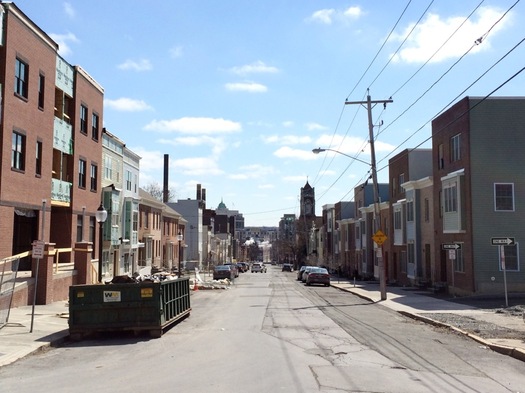
Sheridan Avenue in Sheridan Hollow, looking east toward downtown Albany.
The most interesting real estate project in Albany -- and maybe the whole Capital Region -- has completed its first phase and is now moving onto phase two.
Habitat for Humanity Capital District and a group of partners recently finished building 14 new homes in the Sheridan Hollow neighborhood, and work has already started on another 10 new homes nearby on Orange and Lark streets. At the same time, an org called Housing Visions is building 57 new residential rental units, along with mixed-use space that will include offices and a cafe.
So, what's next? And how does this fit in with downtown Albany's ongoing residential transformation? We stopped by the project this week for a walk and talk with Habitat for Humanity Capital District executive director Christine Schudde.
Destination supermarket as development catalyst
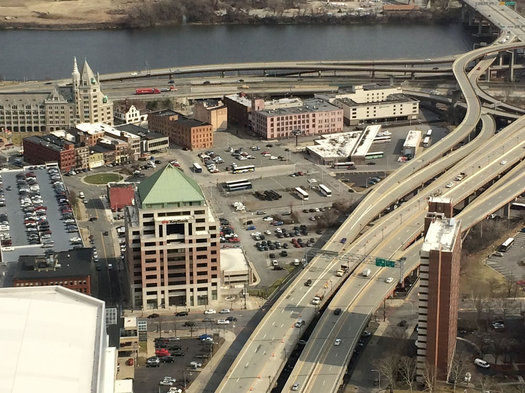
Over at Politico New York, Jimmy Vielkind pitches the idea of using a Wegmans to anchor development at the former convention center site in downtown Albany. A clip:
The Rochester-based grocery chain has a nearly religious following in the areas of upstate New York where it operates, but there are no outposts in the Capital Region. In locating a store at the vacant site downtown, it could simultaneously provide a needed amenity for the struggling neighborhoods nearby and create a regional attraction that would draw people from the surrounding office towers and suburban communities.
Imagine a supermarket with a street-level cafe opening onto Hudson Avenue, beckoning to pedestrians along Broadway and Pearl Street or people in town for a show at the arena or a convention up the hill. Several floors of rental housing or condos above the store -- perhaps with requirements that some units be affordable -- that will give a further boost to the burgeoning residential options in the old business district and prevent the area between the Pastures and Sheridan Hollow, two predominately residential areas, from seeming lifeless after dark.
Call it the Wegmans effect, a development strategy for lagging urban areas rooted in designer cheese. Wegmans, or something like it, could do for Albany what Fairway did for Red Hook.
To be clear: There's no indication that Wegmans is actually considering this -- a spokesperson for Wegmans says as much to Vielkind, noting the company has looked at the Capital Region in the past but seen more opportunity in places such as Maryland and Virginia. And he figures it would take a push from Andrew Cuomo to make it happen.
The former convention site has been the subject of some intrigue recently because the Capital Region's Upstate Revitalization Initiative proposal included mention of an almost unbelievably big "catalyst" project there -- 1,200 housing units, more than 400,000 square feet of office space, and 295,000 square feet of retail. As you know, the Capital Region didn't get one of the $500 million grants. Before that, there had been a pitch to build an aquarium, which also fizzled. Now it's unclear what -- if anything -- is going to happen at the site.
One of the interesting angles to this topic is the question of whether downtown Albany should by vying for some sort of high-profile development piece like a Wegmans or (insert some other large, big-name retailer/project) -- or if it's better off cultivating the steady bit-by-bit development it's experienced in recent years.
Earlier on AOA:
+ The plan for the former Jillian's building, and cultivating retail in downtown Albany
+ Scanning the Capital Region's bid for half a billion dollars from the state
+ Wegmans? Really? Please explain.
The plan for the former Jillian's building, and cultivating retail in downtown Albany
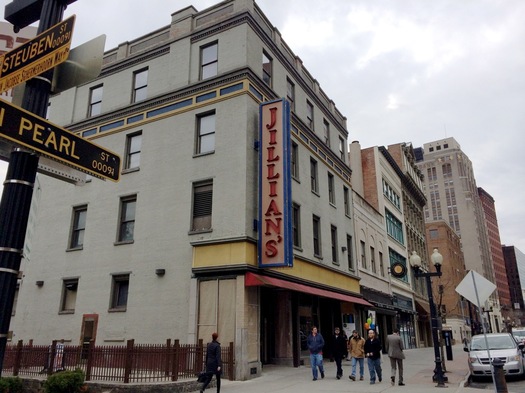
The former Jillian's building on Pearl Street is one of downtown Albany's biggest and most prominent venues. So as the neighborhood has evolved through a series of residential conversion projects and picked up momentum over the past few years, the site has been conspicuous for its lack of activity.
That's now changing. The building has new owners, and they're working to turn it into a spot for a range of different uses. Here's the plan.
Thinking about the future of Lark Street

The state of "The Village in the City."
If there is one constant about cities, it is that they are always changing. Businesses open and close. People move in and out.
In Albany a lot of the recent discussion about neighborhood ebb and flow has been focused on Lark Street and the Washington Park neighborhood. The last few years have seen a lot of change on the stretch of Lark between Madison and Washington, and the recent closing of Justin's leaves another empty storefront on the street.
So is this part of the natural ebb and flow of a neighborhood? Or is it something more?
We asked a handful of people who live, work, and own businesses on Lark Street and in the surrounding neighborhood to share some of their thoughts about the direction of Lark Street -- and to tell us what they'd like to see happen in the neighborhood.
Capital Region gets parting gift in state's economic development award competition
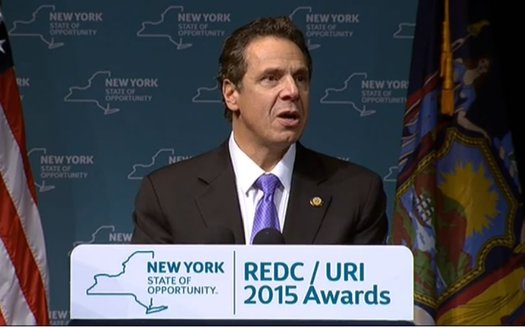
We're really hoping that next Andrew Cuomo will have the regional representatives come up on stage and spin a wheel or something.
update: Here's the list of projects that were awarded REDC money, both in the Capital Region and other regions.. The Capital Region's money will go to a variety of projects including infrastructure, Capital Rep's renovation, the Good Market public market in the Warehouse District, expansion plans at Nine Pin Cider Works, the Tower on the Hudson project, and a music television show to be produced at Proctors.
The list of Capital Region projects from the REDC booklet is embedded after the jump.
______________
The Capital Region left this year's state economic development grant game show with $98.1 million.
Sure, that's a large chunk of money. But the big money this year was in snagging one of the $500 million Upstate Revitalization Initiative awards, a Cuomo admin program inspired in part by the "Bufallo Billion."* The three winning regions for the URI prizes were the Finger Lakes, Southern Tier, and Central New York.
That the Capital Region didn't win one of the URI awards isn't really surprising, It's doing relatively well compared to the rest of the upstate, and it's already benefited from state money for projects like SUNY Poly and GlobalFoundaries. But the Capital Region's economic development council paid the famous consulting firm McKinsey $2 million to help it formulate its plan for the competition, a sign that it thought it had a real shot. (So... refund?) [Biz Review]
Here's a scan of the plan the Capital Region submitted. Officials have said that even if the region didn't win, the plan would still be useful as a map for future economic development.
And here's a scan of the "priority projects" as part of the Capital Region's regular REDC app. Which projects got money -- and how much -- will be out later today.
Here's the list of what each region was awarded...
A quick look at the 733 Broadway residential conversion
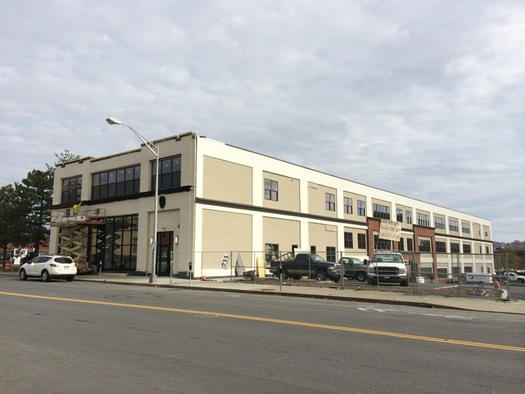
Some quick follow-up on 733 Broadway, the latest residential project in downtown Albany.
The loft-style conversion, the roots of which stretch back to 2005, is aiming for occupancy on December 1, according to Norstar Development.
Here are a few more bits, along with some pics...
Checking back with The Albany Barn
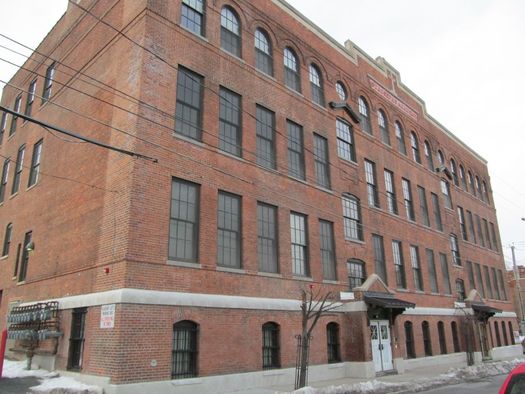
What's happening in there?
The Albany Barn is a weird landlord.
"We kind of like it when people leave," says Barn president Jeff Mirel, "as long as they stay in the neighborhood."
The Barn, of course, is not an actual barn. It's the former Saint Joseph's Academy in Albany's Arbor Hill neighborhood.
More than two years ago it was converted into a mix of HUD-subsidized live/work apartments for artists and studio/theater/office space for art, performance, and community-building activities. The goal: creative placemaking that the Barn's leadership hopes will help the neighborhood with a constant influx of new art and ideas.
"This is a stepping stone for artists," says Mirel of the Barn's assistance to artists, which also includes help with marketing and business. "Success is not required -- trying to achieve is. We say 'Yes, go out into the world, let us serve someone else.'"
Ideally, Mirel says, Barn artists will plant roots in the neighborhood, hiring locally, training young people, and being a part of creating a vibrant area. Meanwhile other artists will move into their affordable spaces at the Barn, so there is always an influx of new artists.
So, that's the plan. After nearly two years, how's it going? And what's next?
Scanning the Capital Region's bid for half a billion dollars from the state
The project floated for this site in downtown Albany is almost unbelievably big.
How do you make the case that you should get $500 million?
The regions competing for one of the three Upstate Revitalization Initiative awards from the state released their plans this week.
We read through the Capital Region's plan -- which includes a proposal for a huge downtown Albany development -- and here are a few things that caught our eye...
Scanning the Capital Region Economic Development Council's proposed priority projects for 2015
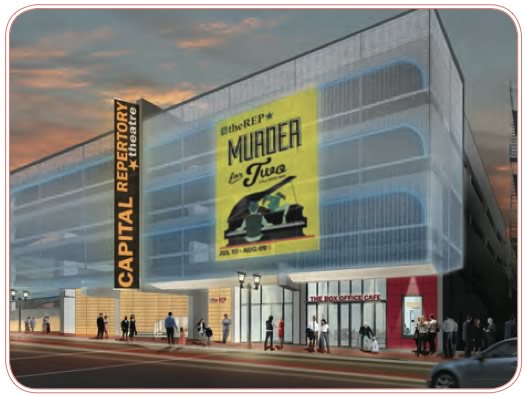
One of the proposed priority projects.
The Capital Region Economic Development Council recently released its list of proposed priority projects for 2015. These are the projects the council will be suggesting get state funding in the next round of the Cuomo administration's Regional Economic Development Council initiative.
Last time out in the state's economic development game show -- er, we mean, regional economic development competition -- the Capital Region scored $60 million.
These reports usually include some interesting bits, and they're can be especially interesting because they often surface notable projects that are in the works.
So, let's have a look at a handful of proposed projects that caught our eye. They include a residential conversion project in Troy, a food court for Albany's Warehouse District, and goats...
Quirky filing for bankruptcy
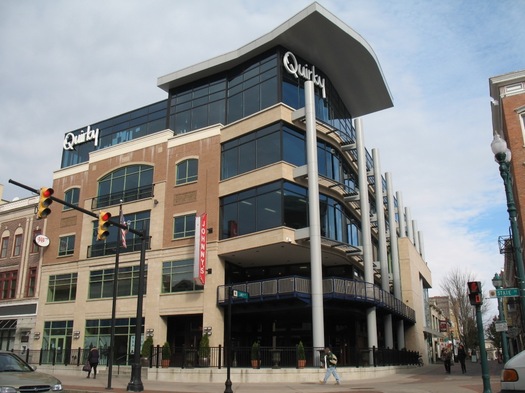
Quirky's office on State Street in Schenectady.
Updated
Quirky -- the consumer products invention company with a large office in downtown Schenectady -- announced Tuesday morning that it's filing for bankruptcy, and says it's working to "facilitate a sale of substantially all of its assets." [Quirky]
The company's office in the City Center building on State Street in downtown Schenectady has served as a customer service operation for Wink, a service for connecting "smart home" appliances (Quirky spun off Wink as it own company). So here's the key local part of the bankruptcy announcement:
With respect to assets related to the business of Wink, Inc., the Company has entered into an agreement with Flextronics International USA Inc. for the sale of certain assets at a purchase price of $15 million. The sale will be subject to higher or otherwise better offers. The Company will look to conduct an auction, if other bids are received, and will be seeking court approval to have the sale close within approximately 60 days. The bankruptcy filing does not impact the Wink experience for users nor how Wink operates day-to-day. Wink's engineers and designers will continue to enhance the Wink platform to provide new, meaningful ways for customers to interact with their smart home. The Wink HUB and Wink Relay will continue to be available at The Home Depot and Amazon. Wink's customer support team will continue to provide the same quality assistance.
Patrick Mahoney, a PR manager for Wink, said today via email that "the Schenectady team is not impacted by this process." And though the company doesn't share office-by-office numbers, he said that Wink overall has 80 employees.
David Buicko of the Galesi Group, which owns the City Center building, told the Daily Gazette today he's confident Wink will stay in Schenectady. [Daily Gazette]
When Quirky's arrival in Schenectady was announced in March 2014, it was touted as A Big Deal that would bring attention and jobs to the city. But there have been rumblings since this past spring that the company was in serious trouble. And this summer founder Ben Kaufman publicly admitted the company was essentially out of money -- he left the company shortly after that. And the word out of the Schenectady office was that things were very shaky (though the company still bought an $8,000 ice cream machine). [Business Insider] [Fortune] [NY Mag] [Daily Gazette]
Earlier on AOA: What is this Quirky in Schenectady?
Do you have an idea for $500 million
 CAPITAL 20.20 -- the working group that's developing the Capital Region's pitch for one of the three $500 million awards in the state's Upstate Revitalization Initiative -- has a series of "town hall" events lined up this week for gathering public input.
CAPITAL 20.20 -- the working group that's developing the Capital Region's pitch for one of the three $500 million awards in the state's Upstate Revitalization Initiative -- has a series of "town hall" events lined up this week for gathering public input.
Project blurbage:
The purpose of each region's Revitalization Plan will be to 1) provide a well-researched and credible argument that the region is ready for revitalization; and 2) to describe the transformation that will happen in the region if granted those funds.
The project is also gathering input via a survey.
The schedule of public events this week is after the jump. The first one is in Colonie late this afternoon (Monday). There are also events in Troy, Schenectady, and Malta this week.
Reading through the Impact Downtown Albany playbook
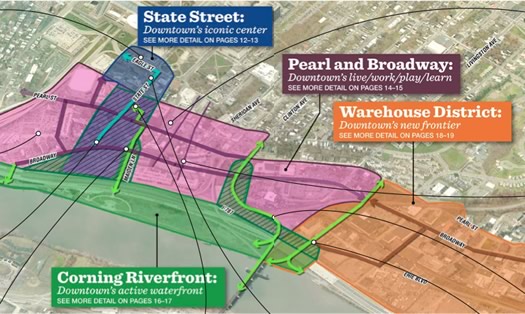
The plan identifies four zones downtown.
The "playbook" for the Impact Downtown Albany project is out. It's aimed to be a set of specific ideas and steps the city can take to continue the redevelopment of downtown Albany -- touching on topics such as residential and retail development, taxes, parking, pop-up events, and branding.
"Impact Downtown Albany was designed as a game changer," said Sarah Reginelli, the president of Capitalize Albany, the city's economic development arm. "It was designed as a tactical approach to downtown revitalization."
The report was produced for Capitalize Albany by a team of consultants over the last two years. Capitalize Albany released it this week so that it might help the Capital Region's bid for one of those $500 million Upstate Revitalization grants from the state.
"Downtown has wonderful assets already, downtown has a strong momentum," Reginelli told us Thursday. "Part of it is changing perceptions of downtown and understanding that this momentum has been occurring and that there is potential here for people to reach out and grab."
We read through the report. And there's approximately three tons of stuff in it. So, if this topic interests you -- go skim through it (pdf). But here are a few chunks of it that caught our eye...
The Warehouse District and thinking about change

We stopped into the public workshop about rezoning Albany's Warehouse District Tuesday evening. It was interesting to hear people talk about their aspirations and concerns for a neighborhood that appears poised for a possible transition to something different. And if anything, it was heartening to see so many people -- more than 50, easily -- commit a few hours to discussing the future of their city on a beautiful summer evening.
Many of the ideas expressed will sound familiar: a desire for walkability, waterfront access, mixed-use housing, boulevarding 787, ways of possibly fostering businesses that draw on the arts, a supermarket. There was also a notable segment of people who wanted to make sure industrial businesses aren't pushed out.
This intensive look at the neighborhood continues through Friday, when there's another public session to discuss some of the work produced by the zoning consultants this week. So we'll probably circle back around to this topic again in the near future because there are a bunch of interesting threads.
But here's one sort-of-big-picture thought we had while listening Tuesday night...
Constructing a new future for Sheridan Hollow

The most interesting real estate project in Albany -- and maybe the whole Capital Region -- is in Sheridan Hollow. Yep, that Sheridan Hollow, the neighborhood that has so often been bypassed, overlooked, and otherwise left with the short end of the stick throughout the city's history.
So what's happening? Habitat for Humanity Capital District and a group of partners are in the process of building a new core at the heart of the neighborhood.
Here are a few reasons why that's so interesting...
Author of Sustainable Communities: Creating a Durable, Local Economy in Troy
 Could be interesting: Bruce Seifer, co-author of Sustainable Communities: Creating a Durable, Local Economy, will be giving a talk this Saturday in Troy as part of a Transition Troy event at Sage.
Could be interesting: Bruce Seifer, co-author of Sustainable Communities: Creating a Durable, Local Economy, will be giving a talk this Saturday in Troy as part of a Transition Troy event at Sage.
Seifer worked for almost three decades leading Burlington, Vermont's community and economic development efforts. Curious about Seifer's perspective, we came across this Peak Prosperity podcast interview with him. This clip, in which Seifer talks about how Burlington pursued business growth, was interesting:
The other thing that we did, which is not rocket science but it's pretty much behind everything that we did, is pretty simple. We asked people in need what they needed and then we tried to figure out how to meet their needs. We were more like a gardener for small businesses. We'd focus on small businesses and try to find ways to help them grow to become major employers and economic players. So, we did things...you know if they needed financing we ended up starting a small business loan fund. If they needed training around understanding finance, we set up training programs for them. Sometimes they said they'd like to work with other like type of businesses and learn from each other. So we would set up trade associations working in concert with them. You know, we would tend to them over the years. We provided ongoing technical business advice to those business people so if they had an issue on getting a permit or they had problem with sewer overflow or whatever it may be, we were always there trying to solve their problems. As a result of all of that, we ended up helping a lot of small companies become bigger companies.
In addition to Seifer's talk, the event at Sage will also include "a few brief, uplifting 'pop-up' presentations from leaders of recent local initiatives."
The event is Saturday, April 11 from 3-6 pm in the Bush Memorial Auditorium. It's free and open to the public.
It won't be the site of the Albany convention center, so what will it be?
What is the next life of the southern edge of Albany's downtown?
That's the question at the heart of the request for proposals (RFP) issued today by Empire State Development for the collection of land that had originally been gathered for a convention center. From the RFP:
With its large size and premier location in the heart of downtown Albany, this Project offers a unique opportunity for a major development in the City's urban core. The Site features convenient proximity to the area's transportation access points and is less than a quarter mile or closer to the City's commercial, cultural and governmental destinations. The Project will serve as a key component of the City's initiatives to attract urban re-investment downtown to meet market demand while simultaneously revitalizing the area with a vibrant mix of uses.
So, yeah, this project -- whatever it ends up becoming, if it ends up becoming -- could be an important part of the ongoing redevelopment of downtown Albany.
Here are a few bits from the RFP that caught our eye, along with a few thoughts...
A push for more, and faster, broadband internet access in New York
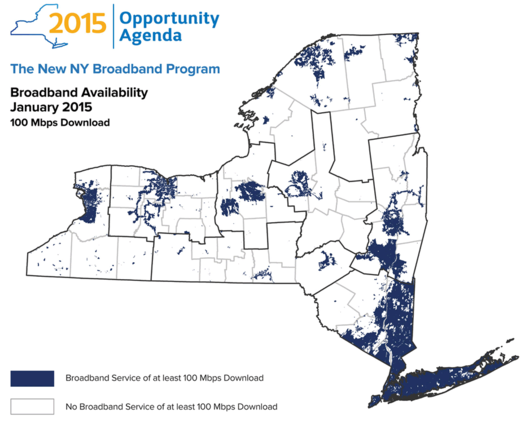
This map depicts parts of the state (in blue) that have access to 100 mbps broadband internet access, according to the Cuomo admin. Here's a larger version, along with county-by-county figures. / map: Cuomo admin
One million people in New York State currently can't get broadband internet access, and 7 million -- including roughly 70 percent of upstate -- can't get access that would be considered very-fast* high speed access.
So reports the Cuomo admin Friday as part of its pitch for a plan to put $500 million of the bank settlement money toward extending broadband internet access to every part of the state by 2019.
The plan aims to use the money as matching grants to private providers to expand access. And one of the conditions of the funding would be that (in most cases) the internet access would have to be at speeds of at least 100 mbps. (For comparison, the "standard" TWC internet connection includes speeds up to 15 mbps.)
"What would it take to turn this into..."

960 Broadway in Albany, viewed from from North Pearl Street.
Maybe you've stood outside one of the Capital Region's many old, underused industrial buildings and thought: "What would it take to turn this into (insert thing)?"
Well, The Preservation League of New York and the Troy Architecture Program have provided some answers to that question. Specifically, they've provided some detailed answers -- about building condition, code issues, variances, and costs -- for what it would take to transform a handful of buildings in Albany, Troy, Schenectady, and Amsterdam.
The reports are the product of the Preservation's League's Industrial Heritage Reuse Project, which is aiming to find new uses for historic former industrial buildings. (As mentioned last summer.)
One example: 960 Broadway in Albany's Warehouse District, which a developer would like to flip to restaurant and residential space.
Capital Region gets $60 million in Regional Economic Development Awards
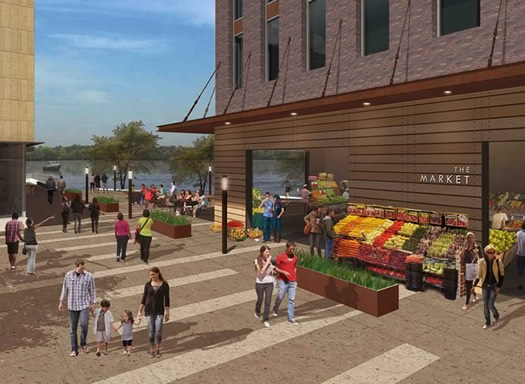
The planned permanent space for the Troy Waterfront Farmers' Market was awarded $1.5 million.
Capital Region projects got a combined $60 million in the Regional Economic Development Council awards announced Thursday. An easy-scan table of the projects is after the jump.
The region snagged $82.8 million last year. But this time around it was not a "top performer" in the state's annual Who Want's to Win Some Pork?!?! game show -- it ended up receiving the second-lowest amount out of the state's 10 regions.
Here are a few of the project awards that caught our eye on the first pass...
Map: Foreclosed properties for sale in Troy

A screengrab of the map.
The city of Troy currently has more than 140 foreclosed properties up for potential sale. The city is accepting sealed bids on the properties -- many of which are vacant land -- between now and December 19.
Here's the list of properties as a pdf. But here's a better way to browse them: a clickable map of the properties along with some of their associated information. (We've also embedded the map after the jump.)
The map is the creation of Anasha Cummings, who was prompted to make it because, as he said to us in an email, "I don't think a PDF on a website is a good way to browse for properties you might want to buy."
Cummings says he's currently in the process of filling in some of the holes in the list (some properties don't have exact addresses) and matching up the properties with more information about them from the city's real property database (important info like square footage, even a photo).
This situation highlights an issue that's frustrated us for a long time: local municipalities often post information/data in ways that make it hard to find or use.
Surveying the Capital Region's creative economy
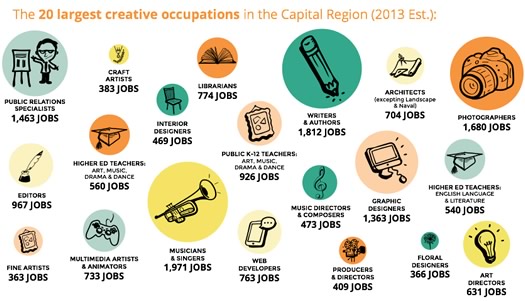
From the report.
The Regional Alliance for a Creative Economy -- a local multi-org effort studying how to spur creative industries in the Capital Region -- released its report on the local creative economy today at Proctors. And -- spoilers -- it found that are many people involved in creative jobs.
The report -- "Leveraging Regional Assets for A Vibrant Future," compiled the consultancy Mt. Auburn Associates -- concluded there are 30,591 jobs in the Capital Region in what it considers creative industries. And it included a bunch of recommendations about how the region could advance these industries and, as the thinking goes, help the region as a whole.
Here are some highlights from the report, and a few thoughts.
Margination: An attempt to create a different sort of local economy
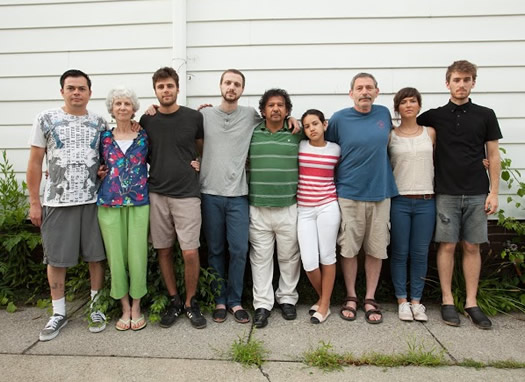
Margination members.
In North Troy there's a group of nine individuals trying to promote economic development and social change with very different approach. This collective, working under the name Margination, is an ongoing experiment in collaboration and interdependency -- sharing financial resources, expenses, even housing.
Their goal is to use the skills of group members to provide secure work and secure housing to demonstrate that anyone with determination can flourish inside of a local economy.
The Gallery on Holland
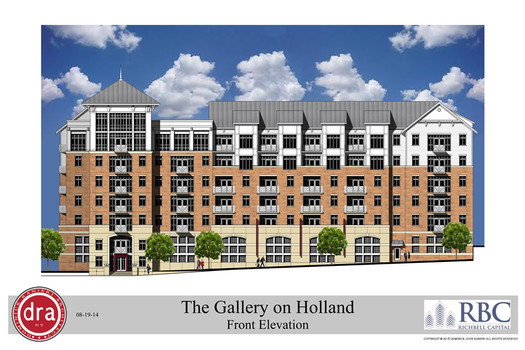
Here's a larger version.
A quick update another apartment project in Albany: The rendering above is for "The Gallery on Holland," a 125-unit apartment building planned for 25 Holland Ave (near the intersection with Delaware Ave). The building will be 7-stories and include 160 interior parking spaces.
This project has been in planning for at least a year -- here's some backstory from August 2013 as reported by Jordan Carleo-Evangelist. It's set to replace the 3-story brick apartment/dorm building currently on the site. The project's been held up by a sewer line issue that required acquiring additional property. Last week it got demolition approval from the city planning board, and it needs one more OK from the city Board of Zoning Appeals before moving ahead. [TU]
The company behind it is Richbell Capital (RBC), which also built the Paddocks of Saratoga. RBC managing director William Hoblock said if the BZA approval comes through and everything lines up as now planned, demolition could start this winter, and the project could be completed by 2016.
Apartment boom
There's currently a bit of an apartment boom (if that's the word) in/around Albany:
+ This 25 Holland project is just about a half mile from the Park South mixed-use project that will include more than 265 residential units.
+ On the city's border with Menands is the loft conversion of the old Albany International headquarters (it was also before the planning board last week).
+ Multiple projects downtown -- completed or planned -- like the Monroe.
+ There are new apartments planned for South Allen Street near St. Peter's
+ A range of smaller conversion projects such as 27 Western (completed) and 960 Broadway (planned, it was before the planning board last week).
+ And today JCE reported two projects planning privately-owned student housing (which are apartments, more or less) near UAlbany's uptown campus. [TU]
This fits into what's apparently a national upswing in apartment construction. [Businessweek]
image: Dominick Ranieri Architect
Scanning the 2014 proposed Capital Region Economic Development Council priority projects

The proposed permanent home for the Troy Waterfront Farmers' Market is one of the projects seeking state funding.
The Capital Region Economic Development Council recently released its list of proposed priority projects for 2014. These are the projects the council will be suggesting get state funding in the next round of the Cuomo administration's Regional Economic Development Council initiative. (Or, as we've come to think of it, a game show called Who Wants to Win Some Pork?) The Capital Region scored almost $83 million the last time out.
Not all of these projects will necessarily get funding (or get funded at the requested levels) but it's interesting to see what's in contention because all sorts of interesting bits bubble up in these applications -- stuff that maybe you missed the first time around, or hasn't gotten a lot of attention.
An example: A company wants to build a free wireless internet access service for downtown Troy.
We put together an easy-scan listing, along with a map, after the jump. We've also highlight a few projects that caught our eye.
The Industrial Heritage Reuse Project

A candidate for conversion to a restaurant and apartments.
The Capital Region has a bunch of former industrial buildings -- some a century or older -- that are currently vacant and under used. And a new project is aiming to map out a future for these buildings.
The Preservation League of New York introduced the Industrial Heritage Reuse Project Wednesday outside a century-old building on Broadway in North Albany that once housed a liquor distributor. That building, along with four others in the Capital Region, will be the subject of analysis looking at how to jumpstart the redevelopment of those buildings for new uses.
"We feel these buildings are assets rather than liabilities," Preservation League president Jay DiLorenzo said on the sidewalk along Broadway.
Three things about the latest big announcement about a new tech something
GE CEO Jeffery Immelt, Andrew Cuomo, Alain Kaloyeros, and a large portion of the Capital Region's state and local reps were at the GE Global Research Center in Niskayuna today for the announcement of a new $500 million consortium that's being touted as both a key part of the next era in electronics and a future generator of thousands of jobs (including "at least 500" in the Capital Region).
The New York Power Electronics Manufacturing Consortium will be anchored by GE and the College of Nanoscale Science and Engineering, and will be backed in part by $135 million in funding from New York State. The consortium will focus on what Kaloyeros called the "next generation of semiconductors," with applications across many different industries.
Here are three things about this announcement -- involving the technology, New York State, and the NanoCollege...
Reuters: GlobalFoundries planning to invest as much as $10 billion more at Malta site

The fab in Luther Forest in Malta.
So, there's planning to spend some money, and there's planning to spend some money. This is the latter: The head of the holding company that owns GlobalFoundries tells Reuters it has received a commitment from its Abu Dhabi state investment fund backers to spend $9-10 billion on expanding capacity at GloFo's facility in Malta.
From the article:
The New York factory, which started operations in 2012, has the capacity to produce 300mm wafers at around 60,000 a month. The wafers are used to create integrated circuits, which are at the heart of all electronic devices.
ATIC wants to expand the factory to produce 20 and 14 nanometer nodes, which will be growth areas in the next three to four years, Ajami said.
Utilizing smaller nodes, crucial parts of computer chips, is a vital part of making electronic devices smaller, such as thinner mobile phones.
Growth rates in the semiconductor industry, which has been hit by falling demand for personal computers as people switch to mobile devices such as tablets, are around the high single- digits, Ajami said.
The Biz Review's Adam Sichko puts the news in some perspective -- the new money would basically double GloFo's investment at the Malta site to date -- and highlights what's still not known -- mainly, whether this means a second fab is on the way. The company has gone through the necessary local approvals for a second fab, but it's yet to publicly commit to building one.
[via @AlbBizHaley]
photo: GlobalFoundries
Almost $83 million for Capital Region economic development projects (with a map)
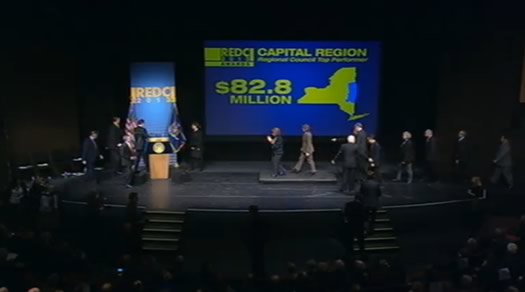
Capital Region, come on down, you just won almost $83 million in pork!
Updated with a map of Capital Region awards, along with an easy-scan table.
The Capital Region scored $82.8 million in funding for projects in the third round of the Cuomo administration's Regional Economic Development Council initiative. A list of the Capital Region projects funded is embedded after the jump.
It was the second-highest total among the state's regions, behind only Long Island's $83 million. And the Capital Region was tabbed as "top performer," meaning it and the other likewise labeled regions got about $20 million more than the, uh, not-top performers. It was a bit of a turn around for the Capital Region's Economic Development Council, which had previously -- what would be Cuomomian word here -- underperformed in the previous two funding rounds. This time the Capital Region's effort was headed up by Albany Med CEO James Barba and UAlbany president Robert Jones.
A few projects that caught our eye as we scanned through the list the first time...
... said KGB about Drawing: What's something that brought you joy this year?